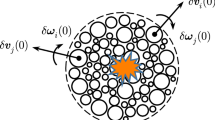Abstract
In multiple operational scenarios, explosive charges are used to neutralize confined or unconfined stores of bacterial spores. The spore destruction is achieved by post-detonation combustion and mixing of hot detonation product gases with the ambient flow and spore clouds. In this work, blast wave interaction with bacterial spore clouds and the effect of post-detonation combustion on spore neutralization are investigated using numerical simulations. Spherical explosive charges (radius, \(R_\mathrm{C}\) = 5.9 cm) comprising of nitromethane are modeled in the vicinity of a spore cloud, and the spore kill in the post-detonation flow is quantified. The effect of the mass of the spores and the initial distance, \(d^0\), of the spore cloud from the explosive charge on the percentage of spores neutralized is investigated. When the spores are initially placed within a distance of 3.0\(R_\mathrm{C}\), within 0.1 ms after detonation of the charge, all the spores are neutralized by the blast wave and the hot detonation product gases. In contrast, almost all the spores survived the explosion when \(d^0\) is greater than 8.0\(R_\mathrm{C}\). The percentage of intact spores varied from 0 to 100 for 3.0\(R_\mathrm{C}\) \(<d^0<\) 8.0\(R_\mathrm{C}\) with spore neutralization dependent on time spent by the spores in the post-detonation mixing/combustion zone.













Similar content being viewed by others
References
Whitney, E.A.S., Beatty, M.E., Taylor Jr. T.H., Weyant, R., Sobel, J., Arduino, M. J., Ashford, D.A.: Inactivation of Bacillus anthracis spores. Emerg. Infect. Dis. 9 (2003)
Setlow, P.: Spores of Bacillus subtilis: their resistance to and killing by radiation, heat and chemicals. J. Appl. Microbiol. 101, 514–525 (2006)
Balakrishnan, K., Genin, F., Nance, D.V., Menon, S.: Numerical study of blast characteristics from detonation of homogeneous explosives. Shock Waves 20, 147–162 (2010)
Kuhl, A.L., Bell, J.B., Beckner, V.E., Reichenbach, H.: Gasdynamic model of turbulent combustion in TNT explosions. Proc. Combust. Inst. 33, 2177–2185 (2011)
Fedina, E., Fureby, C.: Investigating ground effects on mixing and afterburning during a TNT explosion. Shock Waves 23, 251–261 (2013)
Balakrishnan, K., Menon, S.: On turbulent chemical explosions into dilute aluminum particle clouds. Combst. Theor. Model. 14, 583–617 (2010)
Nicholson, W.L., Munakata, N., Horneck, G., Melosh, H.J., Stelow, P.: Resistance of Bacillus endospores to extreme terrestrial and extraterrestrial environments. Microbiol. Mol. Biol. Rev. 64, 548–572 (2000)
Sislian, P.R., Rau, J., Zhang, X., Pham, D., Li, M., Madler, L., Christofides, P.D.: Bacterial aerosol neutralization by aerodynamic shocks using an impactor system: experimental results for B. atropheus spores. Chem. Eng. Sci. 65, 4803–4815 (2010)
McCartt, A.D., Gates, S., Lappas, P., Jeffries, J.B., Hanson, R.K.: In situ optical measurments of bacterial endospore breakdown in a shock tube. Appl. Phys. B 106, 769–774 (2012)
Gottiparthi, K.C., Menon, S.: A study of interaction of clouds of inert particles with detonation in gases. Combust. Sci. Technol. 184, 406–433 (2012)
Balakrishnan, K., Menon, S.: On the role of ambient reactive particles in the mixing and afterburn behind explosive blast waves. Combust. Sci. Technol. 182, 186–214 (2010)
Zukas, J.A., Walters, W.P.: Explosive Effects and Applications. Springer, New York (1997)
Crowe, C.T., Sommerfeld, M., Tsuji, Y.: Multiphase Flows with Droplets and Particles. CRC Press, Boca Raton (1998)
Boiko, V.M., Kiselev, V.P., Keselev, S.P., Papyrin, A.P., Poplavsky, S.V., Fomin, V.M.: Shock wave interaction with a cloud of particles. Shock Waves 7, 275–285 (1997)
Carrera, M., Zandomeni, R.O., Fitzgibbon, J., Sagripanti, J.L.: Difference between the spore sizes of Bacillus anthracis and other Bacillus species. J. Appl. Microbiol. 102, 303–312 (2007)
Gates, S.D., McCartt, A.D., Lappas, P., Jeffries, J.B., Hanson, R.K., Hokama, L.A., Mortelmans, K.E.: Bacillus endospore resistance to gas dynamic heating. J. Appl. Microbiol. 109, 1591–1598 (2010)
Abramzon, B., Sirignano, W.A.: Droplet vaporization model for spray combustion calculations. Int. J. Heat Mass Transf. 32, 1605–1618 (1989)
Kumar, R., Saurav, S., Titov, E.V., Levin, D.A., Long, R.F., Neely, W.C., Setlow, P.: Thermo-structural studies of spores subjected to high temperature gas environments. Int. J. Heat Mass Transf. 54, 755–765 (2011)
Gates, S.D., McCartt, A.D., Jeffries, J.B., Hanson, R.K., Hokama, L.A., Mortelmans, K.E.: Extension of Bacillus endospore gas dynamic heating studies to multiple species and test conditions. J. Appl. Microbiol. 111, 925–931 (2011)
Génin, F., Menon, S.: Studies of shock/turbulence shear layer interaction using large-eddy simulation. Comput. Fluids 39, 800–819 (2010)
Schulz, J., Gottiparthi, K.C., Menon, S.: Ionization in gaseous detonation waves. Shock Waves 22, 579–590 (2012)
Gottiparthi, K.C., Menon, S.: Simulations of heterogeneous detonations and post-detonation turbulent mixing and afterburning. AIP Conf. Proc. 1426, 1639–1642 (2012)
Xu, S., Aslam, T., Stewart, D.S.: High resolution numerical simulation of ideal and non-ideal compressible reacting flows with embedded internal boundaries. Combust. Theor. Model. 1, 113–142 (1997)
Acknowledgments
This work is supported by the Defense Threat Reduction Agency (Dr. S. Peiris, Program Manager). The computational resources are provided by DoD HPC Centers at the US Air Force Research Laboratory DoD Supercomputing Resource Center and Engineer Research and Development Center.
Author information
Authors and Affiliations
Corresponding author
Additional information
Communicated by F. Zhang.
Rights and permissions
About this article
Cite this article
Gottiparthi, K.C., Schulz, J.C. & Menon, S. On the neutralization of bacterial spores in post-detonation flows. Shock Waves 24, 455–466 (2014). https://doi.org/10.1007/s00193-014-0504-9
Received:
Revised:
Accepted:
Published:
Issue Date:
DOI: https://doi.org/10.1007/s00193-014-0504-9




